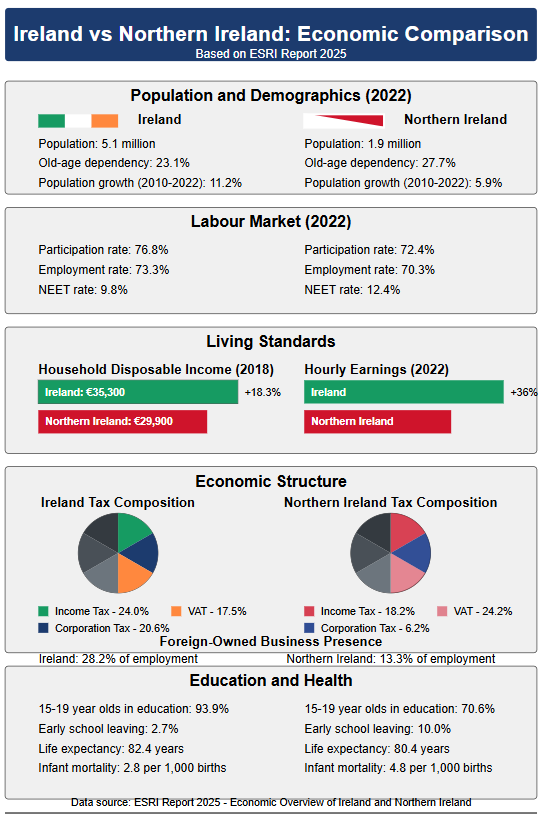- BY Kevin Barry BSc(Hons) MRICS
- POSTED IN Latest News
- WITH 0 COMMENTS
- PERMALINK
- STANDARD POST TYPE

Looking at this ESRI report from a broad perspective, there are several key findings that would be relevant regardless of one’s religious background:
Overall Report Highlights
The report reveals a significant and growing economic divergence between Ireland and Northern Ireland. Key findings include:
- Economic Performance Gap: Ireland shows stronger economic performance across most indicators, with household disposable income 18.3% higher than in NI (2018) and hourly earnings 36% higher (2022).
- Productivity Difference: Labour productivity in Ireland exceeds NI’s in 8 out of 10 economic sectors, with Ireland’s overall productivity more than 2.5 times higher than NI’s.
- Foreign Direct Investment: Ireland has attracted significantly more foreign investment, with foreign-owned firms accounting for 28.2% of employment in Ireland versus 13.3% in NI.
- Tax Structure: Ireland receives substantially more tax revenue from corporation tax (20.6% of total tax receipts) compared to NI (6.2%), reflecting Ireland’s success in attracting multinational corporations.
- Trade Patterns: Brexit has affected trade flows, with NI’s trade with Great Britain declining while trade with Ireland has increased, particularly in NI’s goods exports to Ireland and services imports from Ireland.
Educational Situation in Northern Ireland
The educational indicators for Northern Ireland show concerning trends:
- Declining Enrollment: The percentage of 15-19 year olds enrolled in education in NI is only 70.6%, compared to 93.9% in Ireland. More worryingly, this figure decreased from 73.6% in 2018 to 70.6% in 2022.
- Early School Leaving: The early school leaving rate in NI increased from 9.4% to 10% between 2018 and 2022, while it decreased in Ireland from 5% to 2.7% during the same period.
- NEET Rates: Although improving, the proportion of young people not in education, employment or training (NEET) in NI (12.4%) remains higher than in Ireland (9.8%).
- Tertiary Education Gap: Enrollment rates for 20-29 year olds (typically tertiary education) in Ireland are almost twice those of NI (30.6% vs 16.9%).
These educational trends indicate structural issues in NI’s education system that could have long-term economic consequences by limiting skill development in the workforce. The widening gap in educational attainment between the two jurisdictions may contribute to further economic divergence in the future.
The report suggests that while demographic factors and Brexit have played roles in these differences, policy choices around education, investment, and economic development have been significant factors in shaping these divergent outcomes.
